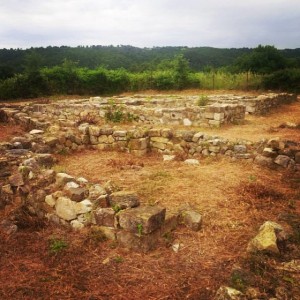
Last weekend, the Luoghi del Tempo festival offered the chance for a visit to the Aia Nova villa. The meeting began with a guided visit to the archeological site that dates back to around the mid 1st century B.C., guided by the director of the Museo Archeologico di Scansano, Marco Firmati – but there were also writers Massimo Carlotto and journalist Alessandro Agostinelli. We were participating with a tasting of our wines and took the chance to shoot some pictures.
For those who were not there, we thought we could tell you a bit about the story of this place.
The Roman times, in Maremma, began with the conquest of Vulci on behalf of the Romans, in 280 B.C. From that moment on, the entire coast from the Tiber to the Albegna river, which together with river Ombrone marks the boundaries of the Docg Morellino di Scansano, was under the control of Rome. In this first phase, the countryside surrounding the settlements founded by the Romans (the Etruscan ones, such as that of Ghiaccio Forte were destroyed by the Romans) was divided into regular parcels that were assigned to individuals. Soon in the area of Scansano too, the landscape was divided in this way and therefore the number of houses of the settlers and farms increased – here, wine was already produced at the time.
The Roman villa of Aia Nova is located in Ripacci, a hamlet of Scansano, and belongs to the second phase, when between the 2nd and the first decades of the 1st century B.C. the first villas were built: wealth was in fact being concentrated and many properties were united to form fewer and larger ones. These monumental, refined and luxurious villas were not just residences but real farms. Among these there was also villa degli Anili or villa di Aia Nova. The name was taken from a sign on the roof tiles on which the name Publius Anilius appears together with an eagle, the symbol of the legion. It is thought that Publio Anilio was a veteran official to whom a propriety in this area was assigned, as customary at the time.
«The villa, excavated only in part by the University of Santa Barbara (California), occupies a large terrace and is supported on its Eastern side by a cryptoporticus that could host warehouses and production structures; an atrium with four columns gave light to the residential rooms among which one can recognize the triclinium and the surrounding cubicula (bedrooms) for private use, and a large salon (oecus) for guests; next to this, one can find the thermal baths with the typical rooms with different temperatures (frigidarium, tepidarium, calidarium) and the outhouse. Decorative bricks and mosaics enriched the floors while there were frescos on the walls» (Marco Firmati, Scansano, Guida al territorio e al Museo archeologico e della vite e del vino).
You can find other info on the history of Maremma here.
[nggallery id=4]